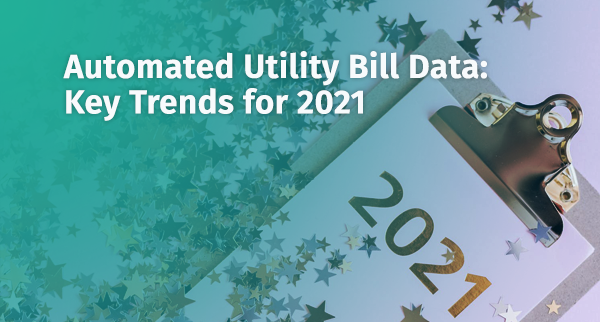2020 was a wild and crazy year, with one key trend: Acceleration of the digital transformation. As we Work From Home, having teams do manual data entry from their living room couches has become an unreliable business process. The race to automate is on!
Many companies want to remove this operational bottleneck, but despite best efforts, not everyone met their automation goal. Here are our top four predictions 2021 to guide next steps.

1) AI is a Must
Companies adopting AI have the power to disrupt their industry in three ways: cutting costs in the back office; producing greater revenues in the front office; and innovating new business models. That’s a pretty fearsome competitor!
So, 2021 is the time to move forward on AI. Not because you want to, but because you have to. Demand to see and test the AI in every software solution you evaluate. Don’t buy without it.

2) Scale with Recipes
Once data is captured from utility bills, it must be structured and normalized to produce a single stream of ready-to-use data. Every utility bill must be mapped to the common data structure. In the data prep and wrangling industry this process is known as creating a recipe.
Recipes are the key to scalability. Humans create the recipe one time and then it can be used over and over. Recipes are auditable, easy to change and provide a shared record of how data is handled. Do you have a recipe for your utility bill data?
3) Transparency and Validation Required
The surge in demand for utility bill data comes from the financial markets. No patience for accuracy errors there. And as you use the data for energy contracts, customized quotes and data visualizations, your credibility is on the line every time inaccurate data flows through. And the cost to fix these errors is high. So ask your solution provider about how you can transparently stay in control of the data capture and transformation, making corrections (if needed) in seconds. WIth transparent AI-powered systems, your trust goes up and your costs go down.
4) Ready to Scale to a Climate Change Solution
Cleantech data and software is having a moment. For decades we have been building the business infrastructure to sell, build and finance clean energy projects at utility, commercial and residential scale. Meanwhile, the enterprise software industry has enabled cloud-based, AI-powered data streams.
In 2021 a third wave will hit our industry, the demand for climate change solutions. And unless we adopt a modern software solution, we will fail to meet the planet’s needs.So our last prediction is also an imperative: We need to break the manual data entry chokepoint, bring in modern cloud-based AI-powered solutions and scale the capture of utility bill data to the needs of our planet.




